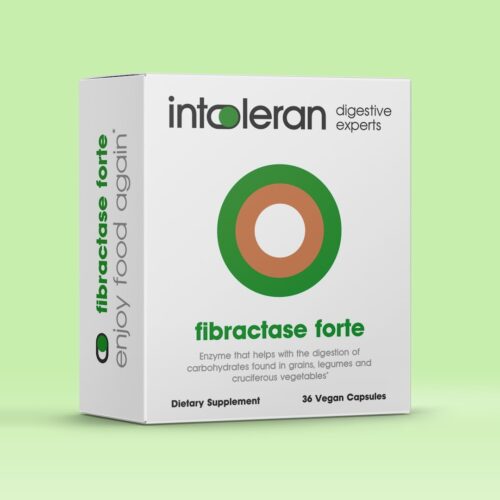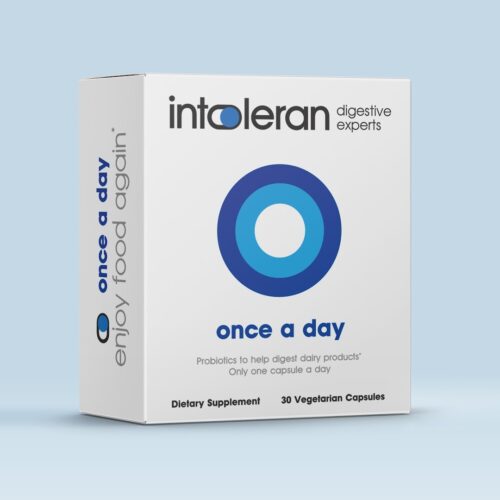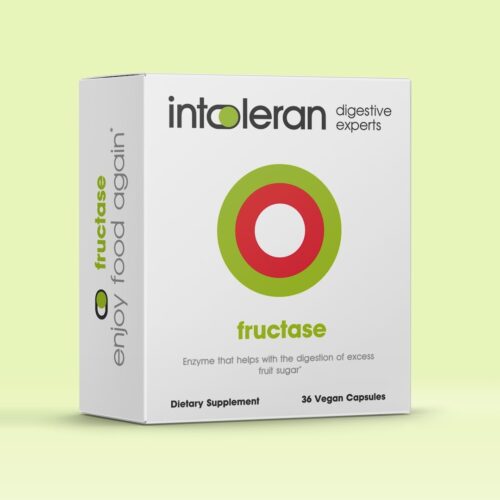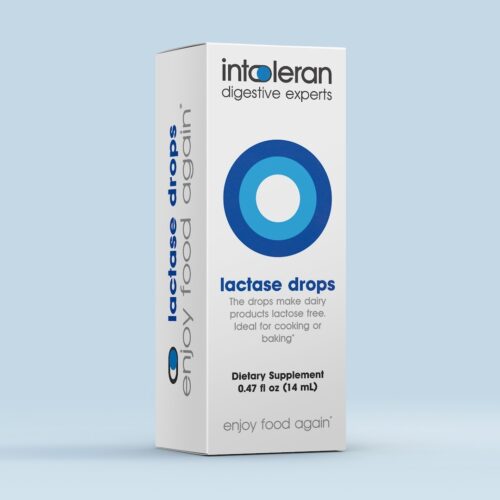FODMAP is a collective name for different types of hard-to-digest carbohydrates that can cause annoying intestinal complaints. You can read more about the different FODMAPs and associated intolerances below.
what are FODMAPs?
FODMAP stands for Fermentable Oligosaccharides, Disaccharides, Monosaccharides and Polyols. FODMAPs are carbohydrates (saccharides) that are poorly absorbed or not absorbed at all in the small intestine and therefore end up in the large intestine. There, bacteria will break them down or ferment them. During the fermentation process, gas can be released which can lead to bloating and flatulence. The fermentation process can also attract liquids which can cause diarrhea or upset bowel movements. These symptoms only occur in people who are sensitive to one or more FODMAPs.
Do you want to find out if you are sensitive to one or more FODMAPs?
→ Do our intolerance test!
Oligosaccharides are polycarbohydrates consisting of 3 to 9 carbohydrate molecules. Within the FODMAP group of oligosaccharides, we know two different types: fructooligosaccharides and galactooligosaccharides, or fructans and galactans. Fructans and galactans occur naturally in various fruits and vegetables and in cereal products, legumes and nuts.
Disaccharides are sugars made out of two carbohydrate molecules. Lactose, also known as milk sugar, is within the FODMAP group of disaccharides. Lactose is a sugar found primarily in milk, other dairy products, and in processed foods.
Monosaccharides are simple sugars that consist of one carbohydrate molecule. Fructose, also known as fruit sugar, is within the FODMAP group of monosaccharides. Fructose occurs naturally in several fruits and vegetables and is added as a sweetener to many processed foods.
Polyols are sugar alcohols and are also called ‘non-intensive sweeteners’. Sorbitol, mannitol, and xylitol are within the FODMAP group of polyols. Most polyols are added as sweeteners to processed (sugar-free) foods. In addition, they occur naturally in certain fruits and vegetables.
which foods contain FODMAPs?
FODMAPs occur naturally in different fruits and vegetables and are also added as sweeteners to many processed foods. Below we have listed the foods in which you will find each FODMAP saccharide. There is also a low FODMAP app from Monash University that allows you to check which FODMAP saccharides are in which foods.
Fructans and galactans occur naturally in a variety of vegetables, fruits, legumes, and grain products. There are foods that contain only fructans or galactans, and there are foods that contain both.
Foods rich in fructans include:
- Garlic
- Onion
- Leeks
- Wheat
- Apricots
- Grapefruit
- Nectarine
Foods rich in galactans include:
- Brown beans
- Chickpeas
- Peas
Foods rich in both fructans and galactans include:
- Cashews
- Pistachios
- Soybeans
- Split peas
Lactose, typically known to be in milk, can also be found in many other foods. Not every product contains the same amount of lactose. Commonly used lactose-containing products are:
- Milk and milk products such as yogurt, custard and cottage cheese
- Cheese, especially fresh cheeses such as cream cheese and cottage cheese
- Cookies and cakes
- Ice cream and milkshakes
- Whipped cream and other types of cream
- Butter
There are also many products in which there is only a small amount of lactose so most people are not affected by it. However, if your body does not produce a lactase enzyme at all, even these small amounts can cause symptoms. For example, some types of medication contain small amounts of lactose, such as asthma medication or other medications with lactose as an excipient.
Note: even ‘lactose-free’ (dairy) products often contain a small amount of lactose. So if you react strongly to lactose, you may also experience symptoms from these products.
Fructose is naturally found mostly in fruits and certain vegetables. In addition, it is often added as a sweetener to processed foods.
Foods that are high in (free) fructose:
- Fruits, such as apple, pear, and cherry
- Vegetables, such as asparagus, artichoke, and sugar snaps
- Fruit juice, such as apple juice and pear juice
- Dried fruits, such as raisins, figs, and dates
- Jams and fruit compotes/sauces, such as apple sauce
- Honey and maple syrup
Many processed products, such as soft drinks, sweets, dressings, and breakfast cereals contain fructose. It is often listed in the ingredient declaration on the label as fructose or glucose-fructose syrup.
Polyols such as sorbitol and mannitol, occur naturally in different fruits and vegetables. Other polyols such as xylitol, are added primarily as sweeteners to processed foods. Polyols-rich foods include:
- Fruits, such as apple, apricot, cherry, pear, peach, and watermelon
- Vegetables, such as avocado, cauliflower, corn, cabbage, and mushrooms
- Coconut
- Sweet potato
- ‘Sugar-free’ products, such as sweets, gum, and soda
how to deal with a FODMAP intolerance
If FODMAPs cause intestinal symptoms, you need to watch what you eat. It is not wise to avoid FODMAPs altogether, but it is possible to limit them. Small amounts of FODMAPs usually do not cause any symptoms, although this can be different for each individual. You can choose a FODMAP-restricted diet, also known as low-FODMAP, or avoid certain FODMAPs, to which you are sensitive, as much as possible. The good news is that you can enjoy your food and drinks even with a low-FODMAP diet. The Internet is full of tips and delicious recipes that allow you to eat low FODMAP and above all, to live with a pain-free stomach.
The FODMAP diet is a way of finding out which FODMAPs you are sensitive to. It is a demanding and complex diet that should always be supervised by the guidance of a dietitian or other health professional. The diet usually consists of three phases:
1. In the elimination phase, all FODMAPs are eliminated from your diet. This involves eating and drinking completely FODMAP-free for several weeks.
2. In the reintroduction phase, the FODMAPs are added back to your diet one by one. After introducing each new FODMAP, you will be able to see whether you experience any intestinal symptoms, and if so, how much. In this way, you discover which FODMAPs you are sensitive to.
3. In the personalization phase, your dietitian will put together a personal diet, taking into account the FODMAPs that cause symptoms and the quantities that you can still tolerate.
There are supplements with digestive enzymes that help digest FODMAPs in your small intestine, preventing them from entering your colon and fermenting there. By taking them with every meal, you can enjoy food containing FODMAPs even with a FODMAP intolerance and prevent symptoms.
Our product quatrase forte helps with the digestion of most FODMAP groups: lactose, fructose, fructans and galactans.
our unique range of products for the digestion of FODMAPs

do my symptoms fit a food intolerance?
intolerance check
free advice from our dietitians
Let us help you with your digestive complaints, like we’ve helped many others. We will help you find the solution that fits your needs best.
Fill out our contact form and we will get back to you

Low FODMAP recipes for everyone
On our recipe page you will find many delicious recipes that are also suitable within a low-FODMAP diet! For example, the recipe for low-FODMAP cake pops.
more food intolerances
read more about different food intolerances
lactose intolerance
Lactose is a type of sugar found in milk and other dairy products, among others. Lactose is normally broken down in the small intestine. There,…
fructans and galactans intolerance
Fructans and galactans are hard-to-digest carbohydrates that many people can have an intolerance to. You can read more about fructan or galactan intolerance below. what…
starch and sucrose intolerance
Starch and sucrose are both carbohydrates and are often found in large quantities in our diet. Some people find them difficult to digest and may…
fructose intolerance
Fructose, also known as fruit sugar, is a type of sugar mainly found in various fruits, vegetables, honey and processed foods. You can read more…
histamine intolerance
Histamine intolerance may not be very well known, but it is still common and can cause annoying symptoms such as skin complaints or intestinal discomfort….
gluten intolerance
Gluten is a protein, found naturally in certain grains such as wheat, spelt, rye, and barley. Gluten, for example, makes bread fluffy and is normally…

 EN
EN NL
NL IT
IT FR
FR ES
ES AU
AU SG
SG




